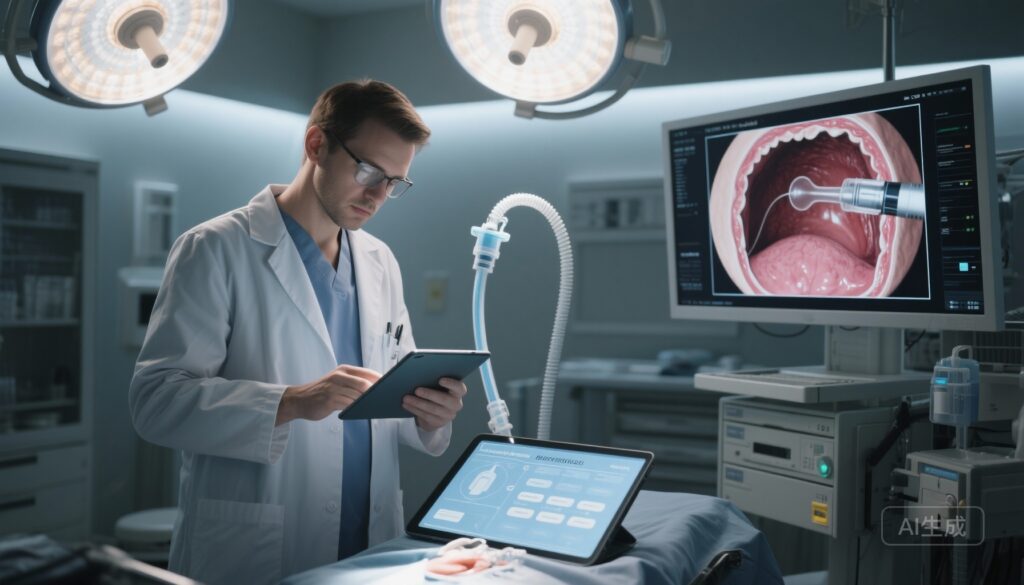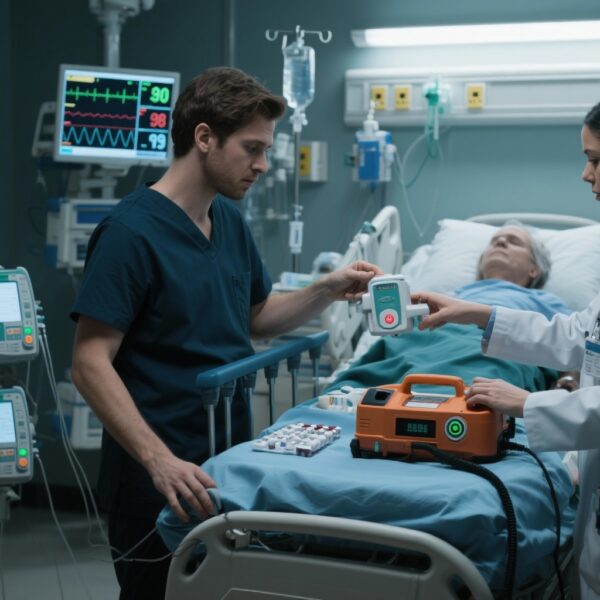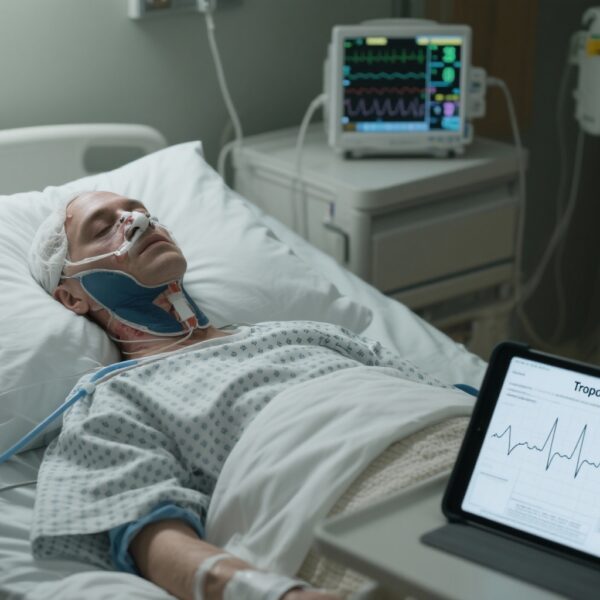Highlights
– Expect-It, a combined-score decision tool using prior airway history, physical exam, clinician ratings, and pharyngolaryngeal/transnasal videoendoscopy findings, was prospectively developed and validated in 1,282 anesthetic cases for head and neck surgery.
– Compared with clinician judgment alone, Expect-It greatly increased sensitivity for recommending camera-assisted (88% vs 35%) and awake (97% vs 29%) tracheal intubation while maintaining noninferior specificity.
– Tool implementation was associated with higher first-attempt success (82% vs 73%) and fewer failed direct laryngoscopies (2% vs 8%), suggesting meaningful clinical impact on airway safety.
Background
Securing the trachea safely is a core responsibility for anesthesiologists, and patients undergoing head and neck surgery frequently present with anatomic distortion or pharyngolaryngeal lesions that increase airway risk. Yet guidance about when to choose camera-assisted (video) laryngoscopy versus direct laryngoscopy, and when to plan for awake versus asleep tracheal intubation, remains imprecise. Traditional decision-making relies on clinician gestalt informed by bedside airway examination and prior history, but single-domain assessments (e.g., Mallampati score) have limited predictive value. In patients with laryngeal or pharyngeal pathology, transnasal flexible videoendoscopy (TNVE) provides direct visualization of lesions and dynamic airway behavior, but how best to integrate such multimodal data into preanesthetic planning is unclear.
Study design
Popal et al. conducted a single-center, prospective two-stage study (development and validation cohorts) that enrolled anesthetic cases for head and neck surgery between May 1, 2021 and January 29, 2022. The authors preoperatively collected airway-related risk factors across four domains: (1) previous intubation difficulty, (2) physical examination findings, (3) physician-rated difficult airway indicators, and (4) pharyngolaryngeal lesion status and TNVE findings. In the development cohort (n=602 cases) clinicians made first-line airway plans according to usual care (nonalgorithm-based). Using regularized regression for variable selection, the authors derived two multivariable logistic models that combined into a single Expect-It score to predict the two primary outcomes: (A) the most appropriate intubation technique (camera-assisted vs direct laryngoscopy) and (B) the most appropriate strategy (awake vs asleep). In the validation cohort (n=680), clinicians used Expect-It to guide planning. The key operational outcomes were tool discrimination (AUC), sensitivity and specificity for appropriate recommendations, first-attempt success, and failed direct laryngoscopy rates.
Key findings
Population and datasets: The final analysis included 1,282 anesthetic cases from 1,201 patients (mean age 50.3 years; 58% male) with 602 cases in the development cohort and 680 in the validation cohort.
Model performance
In the development cohort, the Expect-It tool demonstrated high discrimination: AUC 0.86 (95% CI, 0.81–0.90) for predicting need for camera-assisted intubation and AUC 0.97 (95% CI, 0.96–0.99) for predicting need for awake intubation. The score combined predictors selected by regularized regression from the four predefined domains.
Sensitivity and specificity versus clinical standard
Compared with nonalgorithm-based clinician planning in the development cohort, applying the Expect-It tool markedly improved sensitivity for recommending the appropriate technique and strategy in the validation cohort while maintaining specificity:
- Camera-assisted intubation sensitivity: 88% (95% CI, 81%–93%) with Expect-It vs 35% (95% CI, 27%–44%) with clinician judgment.
- Awake intubation sensitivity: 97% (95% CI, 81%–100%) with Expect-It vs 29% (95% CI, 15%–50%) with clinician judgment.
- Specificity: noninferior for both outcomes (camera-assisted: 97% vs 96%; awake: 100% vs 98%).
Clinical outcomes
After implementation of Expect-It, first-attempt success rates increased from 73% in the development cohort to 82% in the validation cohort (odds ratio 1.72; 95% CI, 1.32–2.22). Failed direct laryngoscopy decreased from 8% to 2% (odds ratio 0.18; 95% CI, 0.09–0.37). These outcome improvements align with the observed increase in appropriate selection of camera-assisted and awake approaches and suggest the tool affected real-world airway management success.
Safety and downstream effects
The study reports reductions in failed direct laryngoscopy and improved first-pass rates but does not provide detailed data on rare adverse events (e.g., severe hypoxemia, airway trauma, unanticipated emergency surgical airway). The preserved specificity suggests reduced overuse of resource-intensive awake techniques, though resource utilization and time costs were not systematically quantified in this report.
Expert commentary and interpretation
Why this matters: Head and neck surgical patients can present airway challenges that are not fully captured by bedside scoring alone. Integrating clinician assessment with direct visualization from TNVE and prior airway history into a formalized decision rule addresses the multidimensional nature of airway risk and reduces reliance on unstructured clinician gestalt.
Strengths of the study: Prospective two-stage design with internal validation; use of regularized regression to reduce overfitting; clinically meaningful outcomes (first-pass success, failed DL); and clear operationalization of inputs across four domains that are commonly available in tertiary head and neck centers.
Limitations and generalizability: The study is single-center, and clinicians were aware of the intervention in the validation phase, creating potential performance or incorporation bias. The population—patients undergoing head and neck surgery—may have higher prevalence of pharyngolaryngeal lesions and TNVE usage than general surgical cohorts, which could limit generalizability to other settings. Also, the gold-standard determination of what constituted the “most appropriate” technique/strategy was the post-intubation anesthesiologist’s retrospective judgment; such labeling may carry subjective bias. External validation across diverse institutions, resource settings, and less specialized practices is needed.
Clinical implications: Expect-It could be implemented as a preanesthetic checklist or embedded in electronic health records to standardize decision-making, prompt timely awake plans where warranted, and reduce failed DL attempts. Reducing failed DL attempts is clinically significant—each failed attempt increases hypoxemia and airway rescue complexity. The high specificity suggests the tool does not meaningfully increase unnecessary awake intubations, a common concern when promoting conservative airway strategies.
Relation to existing guidelines: Current difficult airway guidelines (e.g., American Society of Anesthesiologists Task Force on Management of the Difficult Airway; Difficult Airway Society) emphasize preparation, availability of advanced airway tools, and consideration of awake techniques when airway compromise is anticipated. Expect-It operationalizes these guideline principles by providing a data-driven, objective method to synthesize multiple risk domains and generate a reproducible recommendation.
Conclusion
Expect-It is a promising, prospectively validated decision tool that integrates prior airway history, physical examination, clinician-rated indicators, and transnasal videoendoscopy findings to improve preanesthetic planning for camera-assisted and awake tracheal intubation in head and neck surgery. Implementation was associated with higher first-attempt success and fewer failed direct laryngoscopies. Before broad adoption, external validation across varied clinical settings, assessment of rare complications, workflow and resource impacts, and integration strategies (EHR embedding, mobile apps, clinician training) should be pursued. Expect-It represents a feasible step toward data-driven airway planning and may serve as a foundation for intelligent clinical decision support systems in airway management.
Funding and clinicaltrials.gov
The present summary is based on the published manuscript by Popal et al. (JAMA Otolaryngol Head Neck Surg, 2025). The provided article reference does not include detailed funding or trial registration information in the excerpt summarized here. Readers should consult the original publication for declared funding sources, potential conflicts of interest, and trial registration details.
References
1. Popal Z, Sieg HH, Müller-Wiegand L, et al. Decision-Making Tool for Planning Camera-Assisted and Awake Intubation in Head and Neck Surgery. JAMA Otolaryngol Head Neck Surg. 2025 Jun 1;151(6):585-594. doi:10.1001/jamaoto.2025.0538. PMID: 40310618; PMCID: PMC12046521.
2. Apfelbaum JL, Hagberg CA, Caplan RA, et al. Practice Guidelines for Management of the Difficult Airway: An Updated Report by the American Society of Anesthesiologists Task Force on Management of the Difficult Airway. Anesthesiology. 2013;118(2):251-270. doi:10.1097/ALN.0b013e31827773b2.
3. Frerk C, Mitchell VS, McNarry AF, et al.; Difficult Airway Society Intubation Guidelines Group. Difficult Airway Society 2015 guidelines for management of unanticipated difficult intubation in adults. Br J Anaesth. 2015;115(6):827-848. doi:10.1093/bja/aev371.
AI image prompt for thumbnail
A clinical, photo-realistic image: anesthesiologist consulting a tablet displaying a flowchart decision tool, adjacent monitor shows a flexible transnasal endoscope view of the pharynx, calm operating room environment, neutral lighting, professional medical staff in scrubs, clear focus on tablet and endoscope display, modern hospital aesthetic.



